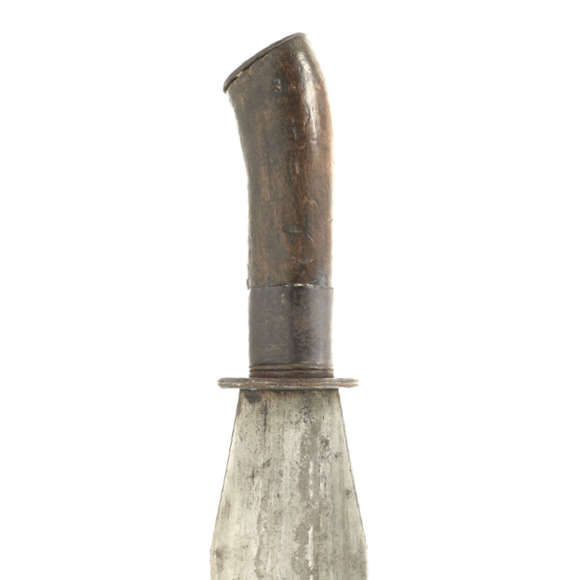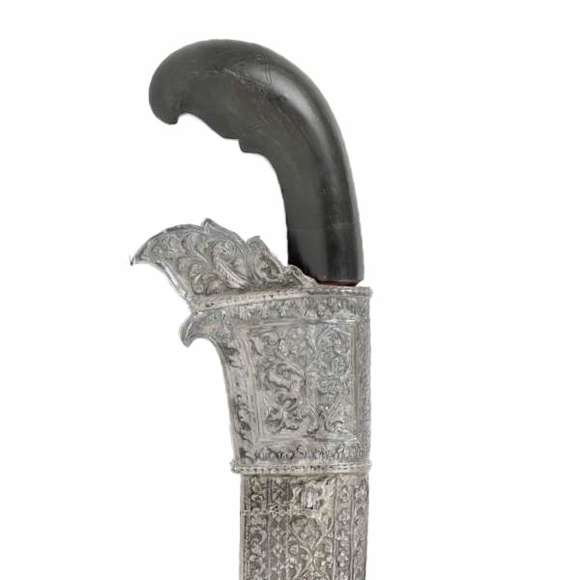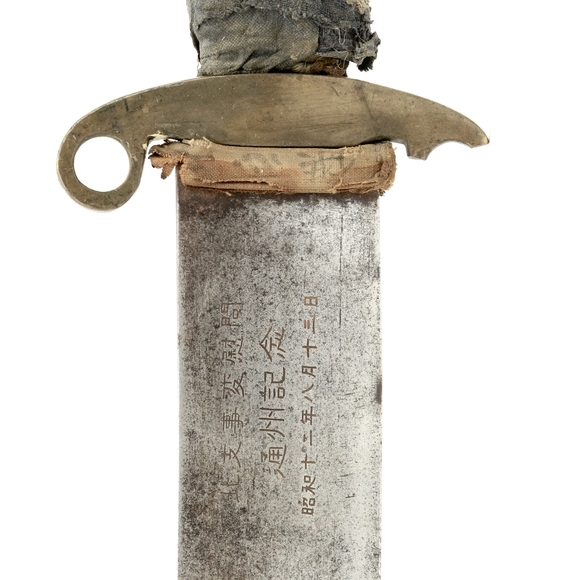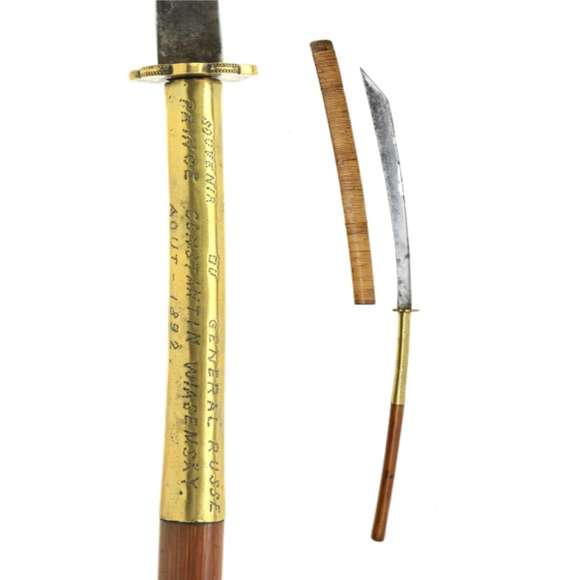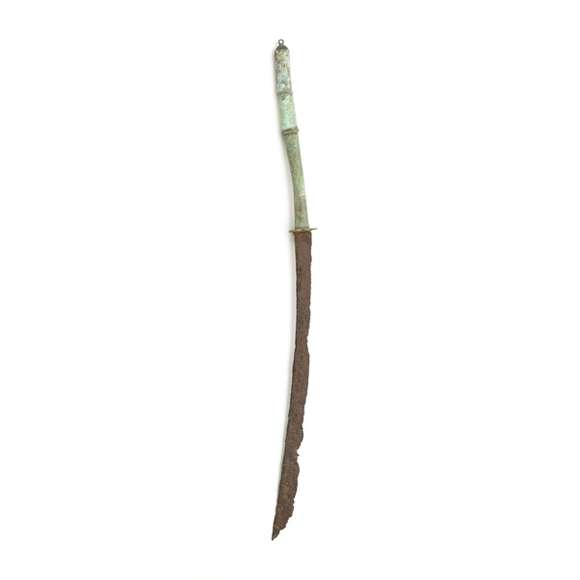Language: Ao language
Source: James Philip Mills, 1926
Description
Noklang is an Ao language name for a number of two-handed, single-edged swords with an all-steel construction. Some authors erroneously apply the term to the Khasi dao, which was also seen among the Ao Naga, but from the literature, it is unclear whether it was regarded a noklang by them.1
From the primary literature:

A drawing by Henry Balfour, then curator of the Pitt-Rivers museum in Oxford.
Published in Mills; the Ao Nagas, page 61.
From the text:
1. Noklang of Konyal type.
2. Noklang of Kichuchar clan, Mokongtsu village, said to have been used by ancestors at Chonghyimti.
3. Ancient "dao" found just below the surface of the ground near Longsa.
4. Ancient ceremonial "dao" exhibited at the mithan sacrifices at Changki (drawn edge upwards).
5. Ancient ceremonial "dao" exhibited at the mithan sacrifices at Changki, the V shaped marks commemorate mithan sacrificed in the past.
6. Ancestral "fish-tailed dao" from Kari village, said to have been brought from Chonghyimti.
Notice that the term noklang is only applied to the first two items. The last piece is what is also known as a variety of the Khasi dao.
Use
By the time foreign observers encountered them, they had already fallen out of practical use and were passed down as heirlooms in wealthy families.
Among the Ao Nagas, the swords only came out only three times a year, during sacrificial ceremonies for good harvest where a mithan, a forest-dwelling buffalo, was sacrificed to the Gods. A pair of these swords was put in the ground upright during the ceremony, and it was considered a bad omen if one of them toppled over.2
What's in a name?
Noklang is synonymous to "a hundred" in the Ao Naga language. A 1985 dictionary of the Ao language lists the entries noklangnok; sword (literally "hundred weapon"), and noklangnüü; sword (literally "hundred spear"). 3
The Ao Nagas used small, key-shaped pieces of iron callled chabli as currency, which were also occasionally owned as heirlooms. I wonder whether there is a connection with the larger sword and its name "a hundred".4 Examples of such currency are in the Pitt Rivers Museum, Oxford, accession numbers 1923.84.179 and 1898.47.2.
Noklang also appears as a name of peoples:
"I have occasionally heard the Nokrangr spoken of as Noklangr, "men of the long daos" noklang being the general Ao word for all obsolete long tanged "daos" whether of the narrow Changki type or ordinary broad pattern." 5
"Another tradition says that some of these refugees turned up into the hills again near the present Konyak village of Anaki. Such, at any rate, is the origin claimed by the Noklang clan of Konyaks in Tamlu and Namsang. Those who did not go down to tho plains founded Nancham." 6
"It is significant in this connection that the Konyaks call the Chami Aos "Noklang," the name given to the refugees from the Ao country who now form a clan in Tamlu and Namsang." 7
The Lotha Naga use the term yanthang for a group of large antiquated swords used for the same ritual purposes.7
Notes
1. Philip S. Rawson; The Indian Sword. London, Herbert Jenkins. 1968. Page 62. Rawson also attributes the weapon to the Lotha Nagas, the Mikirs, and the Bodo but following his footnotes, I did not see this confirmed. The Lotha for example do use large, antiquated dao for ceremonies but they are of a distinctly different type. See the relevant pages for; Lotha, Mikirs, and Bodo.
2. James Philip Mills; The Ao Nagas. Macmillan, London. 1926. Page 61.
3. E. Annamalai, I. S. Borkar, R. A. Singh, Rekha Sharma; Ao - English - Hindi Dictionary. Central Insittute of Indian Languages, Mysore. 1985.
4. James Philip Mills; The Lhota Nagas. Macmillan, London. 1922. Page 44.
5. Ibid. Page 9.
5. Ibid. Page 10.
6. Ibid. Page 13.
7. Ibid. Pages 16-17.
In the literature
"These arms of the Khasi-Jyntia tribes are as peculiar as their language. "The tiny family of Khasi is like an island in the midst of the Tibeto-Burman Sea." - (Robt. Cust, Languages of the E. Indies, p.4.)." 1
-Lord Egerton of Tatton, 1880
Describing their use among the Ao Nagas of Mokokchung:
"Besides these "daos", examples of which are still to be seen from time to time, there are kept in the houses of a few rich men ancient long "daos" (noklang C and M) of unknown origin, which are handed down as heirlooms.
These may be divided into three types, all alike having very long tangs which must have passed right through the haft, so that the "dao" could be stuck upright in the ground. Indeed it is in this way that they are displayed at mithan sacrifices, the only time, apparently, when they are brought out of the house." 2
-James Philip Mills, 1926
Notes to literature
1. Lord Egerton of Tatton; Indian and Oriental Arms and Armour. Dover Publications; Revised edition, 2002. Page 84, fig 19, number 204. Description on page 90.
2. James Philip Mills; The Ao Nagas. Macmillan, London. 1926. Page 60.


